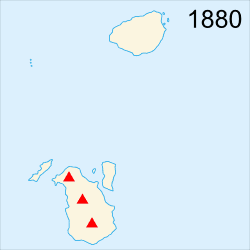Krakatoa
Krakatoa (Indonesian: Krakatau) is a volcanic island situated in the Sunda Strait between the islands of Java and Sumatra in the Indonesian province of Lampung. The island has been the site of repeated massive volcanic eruptions throughout its history. The most notable of these occurred in 1883, one of the deadliest and most destructive volcanic events in recorded history.
History[edit | edit source]
The name "Krakatoa" is used both for the island group, the main island (also called Rakata), and the volcano as a whole. Historical records of volcanic activity in this area date back to the 16th century. However, the 1883 eruption was unprecedented in its scale, causing widespread destruction.
1883 Eruption[edit | edit source]
The 1883 eruption of Krakatoa was one of the most catastrophic natural disasters of the modern era. The eruption and the tsunamis it triggered killed over 36,000 people in the surrounding coastal areas of Java and Sumatra. The explosion was so powerful it was heard as far away as Australia and the Indian Ocean islands, making it one of the loudest sounds ever recorded. The eruption also affected global climate, leading to a noticeable decrease in global temperatures and spectacular sunsets around the world due to the spread of volcanic ash in the atmosphere.
Geology[edit | edit source]
Krakatoa is part of the Indonesian island arc system, resulting from the subduction of the Indo-Australian Plate beneath the Eurasian Plate. The complex consists of several islands, the remnants of a larger pre-1883 island. The main islands are:
- Anak Krakatau (Child of Krakatoa)
- Rakata
- Sertung
- Panjang
Anak Krakatau is the youngest island and has been growing since 1927, emerging from the caldera formed in 1883. It continues to be active, with regular eruptions that have gradually built the island larger over time.
Ecology[edit | edit source]
The eruption of Krakatoa had a profound impact on the surrounding ecosystem, virtually annihilating it. However, the area has since become a fascinating case study of ecological succession, with life slowly returning to the islands. Initial plant life was sparse, consisting mainly of grasses and ferns, but over time, more complex ecosystems have developed. The islands now support a variety of plant and animal life, serving as a natural laboratory for studying ecological recovery and succession.
Impact and Legacy[edit | edit source]
The 1883 eruption of Krakatoa had a significant impact on global climate, the study of volcanology, and even culture and art. It led to the development of the Volcanic Explosivity Index, an important tool in volcanic studies. The spectacular sunsets influenced artists and writers, notably inspiring the vivid skies in Edvard Munch's painting "The Scream".
See Also[edit | edit source]
Search WikiMD
Ad.Tired of being Overweight? Try W8MD's physician weight loss program.
Semaglutide (Ozempic / Wegovy and Tirzepatide (Mounjaro / Zepbound) available.
Advertise on WikiMD
|
WikiMD's Wellness Encyclopedia |
| Let Food Be Thy Medicine Medicine Thy Food - Hippocrates |
Translate this page: - East Asian
中文,
日本,
한국어,
South Asian
हिन्दी,
தமிழ்,
తెలుగు,
Urdu,
ಕನ್ನಡ,
Southeast Asian
Indonesian,
Vietnamese,
Thai,
မြန်မာဘာသာ,
বাংলা
European
español,
Deutsch,
français,
Greek,
português do Brasil,
polski,
română,
русский,
Nederlands,
norsk,
svenska,
suomi,
Italian
Middle Eastern & African
عربى,
Turkish,
Persian,
Hebrew,
Afrikaans,
isiZulu,
Kiswahili,
Other
Bulgarian,
Hungarian,
Czech,
Swedish,
മലയാളം,
मराठी,
ਪੰਜਾਬੀ,
ગુજરાતી,
Portuguese,
Ukrainian
Medical Disclaimer: WikiMD is not a substitute for professional medical advice. The information on WikiMD is provided as an information resource only, may be incorrect, outdated or misleading, and is not to be used or relied on for any diagnostic or treatment purposes. Please consult your health care provider before making any healthcare decisions or for guidance about a specific medical condition. WikiMD expressly disclaims responsibility, and shall have no liability, for any damages, loss, injury, or liability whatsoever suffered as a result of your reliance on the information contained in this site. By visiting this site you agree to the foregoing terms and conditions, which may from time to time be changed or supplemented by WikiMD. If you do not agree to the foregoing terms and conditions, you should not enter or use this site. See full disclaimer.
Credits:Most images are courtesy of Wikimedia commons, and templates Wikipedia, licensed under CC BY SA or similar.
Contributors: Prab R. Tumpati, MD




